
ACT Science Practice Test 20
Đề thi nằm trong bộ sưu tập: Tuyển Tập Bộ Đề Thi Đại Học Hoa Kỳ (ACT) - Có Đáp Án Chi Tiết
Số câu hỏi: 29 câuSố mã đề: 1 đềThời gian: 1 giờ
215,786 lượt xem 16,594 lượt làm bài
Xem trước nội dung:
A gene is composed of a series of exon and intron segments. Exons are the coding regions of a gene, the segments that contain the instructions for building a protein. A gene's exons are connected by noncoding regions, or introns.
To build a protein, the cell must first transcribe the gene into messenger RNA (mRNA). Then a process called RNA splicing removes the noncoding introns and connects all of the exons to produce an mRNA transcript that can be used to build the protein.
Tropomyosins are a family of proteins that help maintain the cytoskeleton structure in all cells and support the contraction of muscle cells. In the late 1980s, a group of scientists discovered that the alpha-tropomyosin (α-TM) gene can code for several different tropomyosin proteins within different tissues of the same organism.
Figure 6.1 shows the structure of the seven mRNA transcripts identified as the result of the scientific study. In each transcript, each box represents an exon. Each transcript was found to be a product of the same α-TM gene.
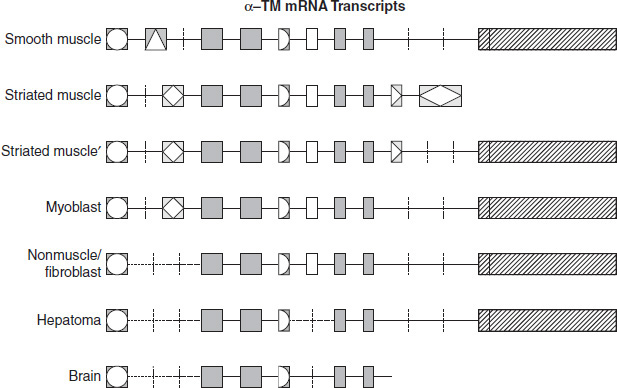
Figure 6.1
Source: http://www.bio.utexas.edu/research/tuckerlab/bright/phylo_3_10_04/index.html.
Scientists continue to study the α-TM gene as a model of alternative splicing, in which mRNA transcripts containing different combinations of exons can lead to the production of different proteins. Figure 6.2 shows the structure of the α-TM gene, which is composed of 12 exons connected by 11 introns.

Figure 6.2
Each exon in a gene codes for a specific series of amino acids in the corresponding protein. The complete α-TM gene codes for a protein composed of 284 total amino acids. Table 6.1 shows the series of amino acids coded by each of the 12 exons in the α-TM gene.
TABLE 6.1 Alpha-Tropomyosin Exon
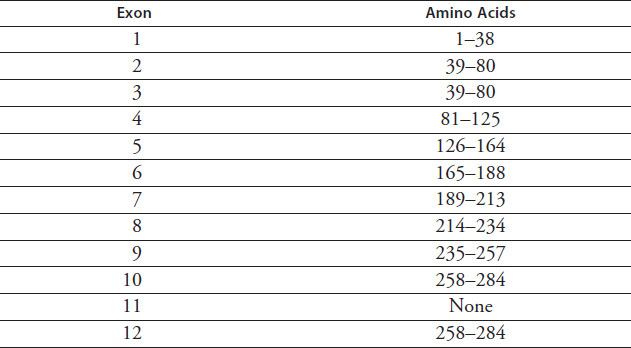
Source: http://www.bio.utexas.edu/research/tuckerlab/bright/phylo_3_10_04/index.html.
To produce a tropomyosin protein, which of the following steps must occur first?
The introns are removed from the α-TM mRN
Exons are alternatively spliced to code a specific tropomyosin.
The α-TM gene is transcribed into mRN
Amino acids are arranged based on the α-TM mRNA sequence.
According to the passage, each mRNA transcript in Figure 6.1 is produced from:
the same gene.
multiple genes.
an independent gene.
the same tissue.
In Figure 6.1, what is the maximum number of exons present in an mRNA transcript?
10
7
9
11
Constitutive exons are present in all mRNA transcripts of a gene and are thought to be integral in the proteins' basic structure. Which of the following exons appears to be constitutive?
Exon 3
Exon 7
Exon 12
Exon 4
Alternatively spliced exons (ASEs) are those that only appear in certain mRNA transcripts. Which of the following cell types appears to have the least number of ASEs?
Myoblast
Brain
Nonmuscle/fibroblast
Smooth muscle
Which exons do not appear in any of the same mRNA transcripts?
Exons 10 and 12
Exons 7 and 11
Exons 2 and 3
Exons 3 and 11
Two types of muscle tissues-skeletal and cardiac-are both striated. Based on Figure 6.1, how do the α-TM mRNA transcripts of skeletal and cardiac muscle tissues differ?
One transcript contains a greater total number of exons.
The exons present in one transcript are absent in the other.
One contains Exon 2, while the other contains Exon 3.
Each transcript contains a different final exon.
The total number of exons in the α-TM gene is:
unknown.
12
variable.
11
Based on the data in Table 6.1, which α-TM exon codes for the longest sequence of amino acids?
Exon 8
Exon 4
Exon 11
Exon 6
Which α-TM mRNA transcript is missing amino acids 258-284?
Hepatoma
Myoblast
Smooth muscle
Brain
Based on Table 6.1, which mRNA transcript contains a repeated sequence of amino acids?
Striated muscle
Nonmuscle/fibroblast
Smooth muscle
Brain
A myoblast is an embryonic cell that can differentiate into a muscle cell. Based on Figure 6.1, which of the following happens to the α-TM mRNA transcript when a myoblast differentiates into a smooth muscle cell?
Exon 10 is added.
Exon 3 is replaced by Exon 2.
Exon 12 is replaced by Exon 11.
Exon 10 is removed.
Untranslated regions (UTRs) are sequences that exist at the beginning and end of every mRNA transcript. Instead of coding for amino acids, UTRs regulate the expression of the transcribed gene. In the α-TM mRNA, Exons 1 and 12 both contain UTRs. Based on the data in Table 6.1, which other exon contains a UTR?
Exon 5
Exon 8
Exon 11
Exon 3
The passage states that in addition to their function in all cells, tropomyosins also support contraction in muscle cells. It can be inferred that this extra function is related to which of the following sequences of amino acids?
Amino acids 39-80
Amino acids 81-125
Amino acids 258-284
Amino acids 1-38
A hepatoma is a tumor that forms within the liver. Based on Figure 6.1, it can be inferred that tumor formation may correlate to a loss of which exon?
Exon 2
Exon 10
Exon 11
Exon 7
Over the past several decades, scientists have seen a rapid decline in honeybee populations worldwide. In an effort to boost population sizes, the European Union recently instituted a temporary two-year ban on neonicotinoids, a class of pesticides thought to be harmful to honeybees.
Two scientists present their viewpoints regarding the value of instituting a similar ban in the United States.
Scientist 1
A short-term ban on the class of pesticides called neonicotinoids is a viable option that should seriously be considered by the United States. Studies have found neonicotinoid concentrations in pollen and nectar that can be lethal to pollinators. Although research has not identified a direct link between neonicotinoids and a reduction in honeybee populations, recent studies suggest that these pesticides may increase honeybees' susceptibility to parasites and diseases. The health of honeybee populations directly affects the agriculture industry and the overall ecosystem. Twenty-three percent of crops grown in the United States are pollinated by honeybees. Some crops, such as almonds, apples, onions, and carrots, are pollinated almost exclusively by honeybees. The reproductive rates of these crops vary directly with the availability of honeybees. Many of the plants that make up the base of the food web in the natural ecosystem also rely on these pollinators. Because the honeybee's role as pollinator is so pervasive, any measures that have the potential to support the health of honeybee populations should be taken.
Scientist 2
Honeybees are important pollinators for both natural ecosystems and the agriculture industry, and the health of their populations should be monitored closely. Instituting a ban on neonicotinoids, however, is unnecessary. Based on current research, the benefits of neonicotinoid use to the agriculture industry outweigh the threat to honeybee health. Though the exact causes are difficult to identify, researchers attribute the decrease in honeybee populations in recent years to weather, environmental stress, disease, and varroa mites. Environmental stressors include nectar and water that is scarce or of poor quality and exposure to pesticides, although researchers have found the latter to have the weakest correlation to honeybee loss of all stressors. Therefore, a ban on neonicotinoids will not be an effective approach for improving the health of honeybee populations. A more effective method should address varroa mites and disease, the greatest known threats to honeybee health.
According to the passage, neonicotinoids are a type of:
parasite.
pollinator.
pesticide.
pathogen.
According to Scientist 1, neonicotinoids:
have been directly linked to declines in honeybee populations.
affect honeybees by increasing their vulnerability to parasites.
provide agricultural benefits that outweigh the risk to honeybees.
are the greatest threat to honeybee health in the United States.
Scientist 1 identifies all of the following crops as being highly dependent on pollination by honeybees except:
cherries.
almonds.
carrots.
apples.
The major difference between the two scientists' viewpoints is that:
Scientist 1 believes honeybee populations should be saved, while Scientist 2 believes humans should not interfere with honeybee populations.
Scientist 1 believes all threats to honeybee health should be addressed, while Scientist 2 believes that efforts should focus on the greatest threats to these populations.
Scientist 1 believes honeybee populations are declining in the United States, while Scientist 2 believes that honeybee populations are stable.
Scientist 1 believes neonicotinoids are harmful to honeybees, while Scientist 2 believes neonicotinoids do not pose any threat.
According to Scientist 1, which of the following graphs best represents the relationship between honeybees and producers in an ecosystem?
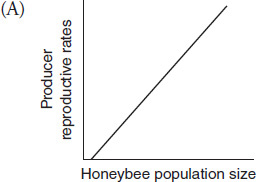
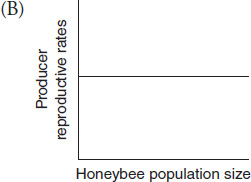
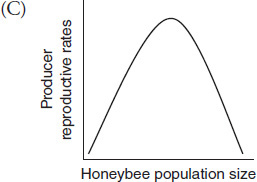
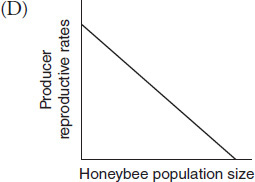
Which of the following does Scientist 2 identify as the greatest threats to honeybee populations in the United States?
Varroa mites and disease
Neonicotinoids and weather
Disease and nectar quality
Water and nectar scarcity
Which factor affecting honeybee health was discussed by Scientist 2 but not by Scientist 1?
Pesticides
Disease
Parasites
Water quality
It can be inferred that Scientist 1 believes honeybees' most important role in natural ecosystems is to:
act as a host for varroa mites.
provide a food source for birds.
transfer pollen between plants.
compete with other bee species.
According to Scientist 2, which graph best represents the relationship between neonicotinoid exposure and honeybee health?

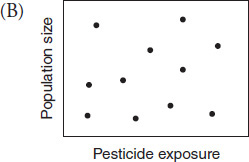

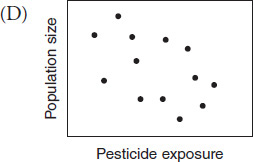
A doubling of the average honeybee population size in Europe over the next five years would support the opinion of:
both scientists.
neither scientist.
Scientist 1.
Scientist 2.
Based on the information in the passage, both scientists would support efforts to:
institute a one-year ban on neonicotinoids in the United States.
improve disease and parasite prevention in honeybee populations.
reduce private consumer use of pesticides near honeybee habitats.
monitor changes in the size of honeybee populations without interfering.
According to Scientist 1, approximately what proportion of the agriculture industry in the United States is dependent on honeybees?




If Scientist 2 is correct, which of the following trends is most likely to be seen if a ban on neonicotinoids is enacted in the United States?
Honeybee populations will continue to decline at the preban rate.
Honeybee populations will begin to increase at a rapid rate.
Honeybee populations will continue to decline but at a slower rate.
Honeybee populations will begin to increase at a moderate rate.
If Scientist 2 is correct, it can be inferred that honeybee health is most strongly affected by:
seasonal conditions.
resource availability.
human interference.
biotic factors.
